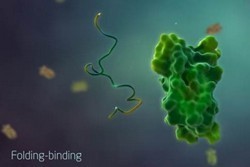The functional role of proteins
Five top-notch institutes in biomedical research partnered under the EU-funded project IDPBYNMR(opens in new window) (High resolution tools to understand the functional role of protein intrinsic disorder) to investigate the functional role of such intrinsically disordered proteins (IDPs). Nuclear magnetic resonance (NMR) provided atomic scale resolution for protein characterisation after developing suitable methods and complementary techniques. Newly recruited PhD students worked on challenging research projects to obtain potentially useful experimental data for determining the structure-function relationship of IDPs. Several intensive training courses were also conducted, involving major experts in the fields to provide multidisciplinary expertise. IDPBYNMR researchers have developed new computational techniques and NMR methods for studies on IDPs in cellular systems. Viral IDPs associated with hijacking cell regulation and amyloids linked to several diseases were successfully characterised. Other IDPs of significance included amyloids that also play a central role in several diseases. The scientists designed and completed the database for IDP and experimental data. A paper giving details of the database(opens in new window) has been published in Nucleic Acids Research. Dissemination includes a book, published by Springer, 'Intrinsically Disordered Proteins Studied by NMR Spectroscopy'(opens in new window) and a project video(opens in new window). Papers have been published in peer-reviewed journals – PLoS ONE, Nature Communications and Nucleic Acids Research. Groundbreaking project activities could be the key to developing new educational and training programmes for this relatively new field of IDPs. Potential applications are numerous particularly in the biomedical and pharmaceutical sector. This promises to lead to the development of novel and effective drug candidates and biomarkers to detect, treat and monitor treatment progress in patients.







